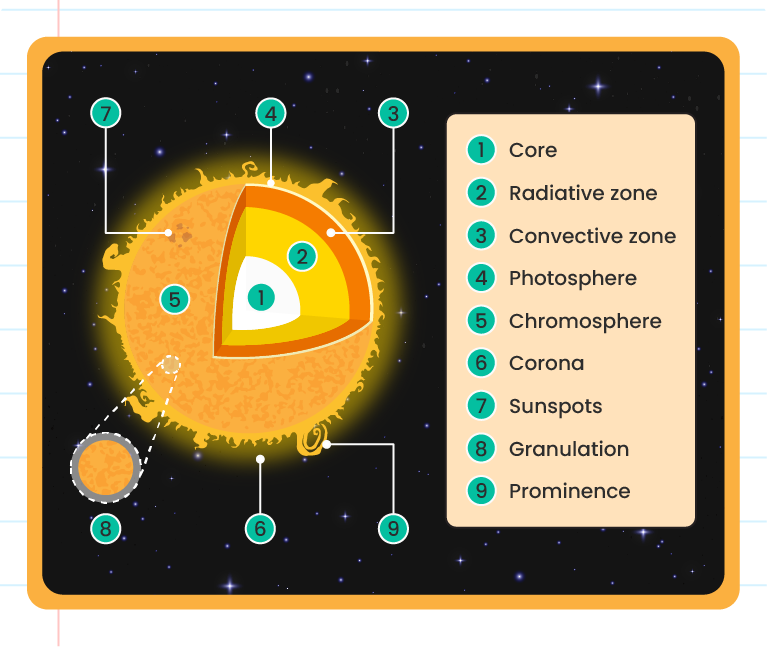| 9.1 |
Activities of the Sun that Affect the Earth |
The structure of the Sun:


The characteristics of each layer of the Sun:
|
Layers
|
Features
|
|
Core
|
- The deepest layer at the center of the Sun
- The temperature is about 15 million ° C
- Allows thermonuclear fusion to take place
- Heat energy and sunlight come from the combination of hydrogen nuclei that form helium at the center of the Sun
- The source of the Sun's energy
|
|
Radiation zone
|
- The layer of the Sun between the core and the convection zone
- Energy from the Sun's core travels outward through the radiation zone in the form of electromagnetic radiation (photons)
- The radiation zone extends 70% of the Sun's core, which is approximately at a depth of 200,000 - 515.00 km below the Sun's surface
- The thickness of the radiation zone varies between stars and some have no radiation zone
|
|
Convection zone
|
- The Sun's layer above the radiation zone and below the photosphere
- Consists of plasma, like the whole of the Sun
- Plasma is a type of gas that can conduct electric current
- The convection zone extends from a depth of 200,000 km to the photosphere
- Electromagnetic radiation from the radiation zone moves to the convection zone producing an outward vortex (rotating plasma)
- The flow of energy moves in a vortex forming convective cells as in a boiling kettle
|
|
Photosphere
|
- The surface layer of the Sun can be seen with the help of a telescope
- The temperature is about 6,000 ° C and the thickness is about 300 km
- The sunlight that can be seen from the Earth comes from the photosphere
- Convection occurs due to explosions that occur on the surface of the Sun
|
|
Chromosphere
|
- The layer on top of the photosphere
- The temperature is about 4,400-25,000 ° C with a thickness of about 2,000 km
- The chromosphere appears as a red circle around the Moon during a solar eclipse
- The red color is produced by hydrogen gas at high temperatures
|
|
Corona
|
- The Sun's outermost layer and extends millions of kilometers into outer space
- The temperature is about 1 million ° C and forms a bluish-white circle that appears during a solar eclipse
|
The phenomenon that occurs on the surface of the Sun:
|
Phenomenon
|
Situation
|
|
Granules
|
- Looks like an arrangement of cells on the surface of the photosphere
- Due to the plasma convective current in the convection zone
|
|
Sun spots
|
- Dark spots in the Sun's photosphere
- It is the cooler part of the photosphere layer and is influenced by the strength of the Sun's magnetic field
|
|
Solar flares
|
- A strong eruption of radiation caused by the release of magnetic energy around the sun's spots
- Releases electrons, ions and atoms and emits long radiation
- The electromagnetic spectrum from radio waves to gamma rays and into outer space
- Emitted to Earth causes aurora events and disrupts telecommunication systems and satellite functions
|
|
Bright solar
|
- Solar eruptions that start from the photosphere to the corona
- The glowing red ring is plasma, which is a hot gas composed of electrically charged hydrogen and helium
|
|
The mass of the corona
|
- The release of a cloud of particles i.e. plasma and a strong magnetic field from the corona into outer space
- Produced alone or together with solar flares or bright solar
- Contains billions of tons of mass that can reach speeds of several million kilometre per hour
- It is a cloud of particles thrown into outer space and moves slower than a solar flare
|
|
Solar wind
|
- In the corona, the temperature of about 1 million ° C of the Sun's gravitational pull is not strong enough to withstand the fast-moving charged particles and then be released into space
- The flow of charged particles released from the corona is known as the solar wind
- Characteristics such as magnetic field, velocity, temperature and density of the solar wind depend on the activity on the surface of the Sun according to the solar cycle
|
|
The solar cycle
|
- The electrically charged sun produces a strong magnetic field, the magnetic field undergoes a cycle of activity called the solar cycle
- A solar cycle takes about 11 years
- In a solar cycle, the poles of the Sun's magnetic field will change places
- The Sun’s magnetic field at the north pole and south pole changes each solar cycle
- The solar cycle affects activity on the surface of the Sun.
|
The Earth's Magnetosphere:
The formation of the earth's magnetosphere:


-
The Earth's magnetosphere stems from the Earth's magnetic field
-
The Earth's magnetic field is generated from an electric current generated from the movement of a convective current of molten iron in the Earth's outer core
-
The shape of the Earth’s magnetosphere is produced by the Earth’s magnetic field that protects the Earth from solar angina from the Sun
-
The collision of the solar wind with the Earth's magnetic field is known as bow shock because it is arc-shaped
-
Without the magnetosphere, the solar wind would destroy the Earth’s atmosphere
-
The effect of no Earth's atmosphere is that air will disappear from the Earth's surface, water will not exist in liquid form, and harmful ultraviolet radiation will reach directly to the Earth's surface because there is no ozone layer